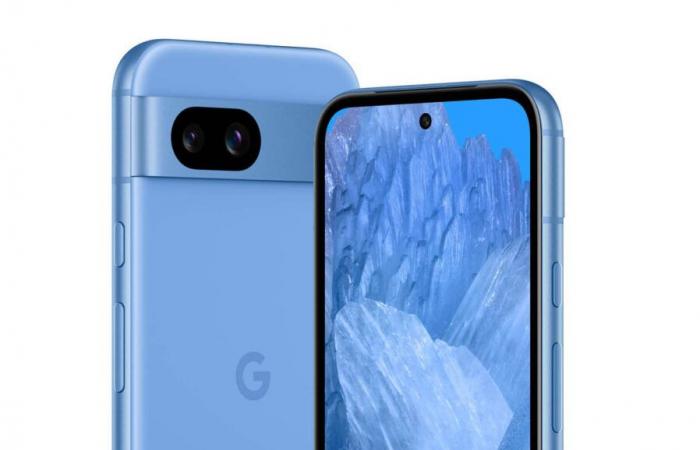Each model is distinguished by its design and the arrangement of its photo sensors, thus contributing to aesthetics and ergonomics. The Google Pixel 8a sports a bar integrating its two photo sensors, occupying the entire width of the device, a distinctive style available in blue, green, black or white. Its profile remains rounded, making it easier to hold. Samsung’s Galaxy A55, for its part, adopts a refined aesthetic with a glass back where the photo sensors appear simply placed, without framing, giving it a certain visual lightness. It comes in blue, dark blue, lilac and lime, and features a domed effect around the side buttons.
As for the Xiaomi Redmi Note 13 Pro, it opts for flat profiles with a plate housing the photo sensors in the same tone as the rest of the case, available in black, purple and blue.
In terms of dimensions, the Google Pixel 8a is the most compact model (152.1 mm in height) while the Galaxy A55 is the most imposing with its 161.1 mm. In terms of weight, the Galaxy A55 is also the heaviest (213 g) compared to the Redmi Note 13 Pro which, with 187 g, is the lightest of the three. In terms of water resistance, the Google Pixel 8a and the Galaxy A55 benefit from IP67 certification, giving them relative waterproofness, while the Redmi Note 13 Pro is certified IP54, a level of protection against low splashes. intensity.
Which is the most powerful and which is the best screen?
In terms of power, each of these smartphones offers a powerful processor, suitable for daily use. The Google Pixel 8a works with the Tensor G3, accompanied by 8 GB of RAM and 128 or 256 GB of internal storage, but without the possibility of expansion. The Samsung Galaxy A55 uses an Exynos 1480, supported by 8 GB of RAM as well as an additional 8 GB virtual RAM option. Its storage can also be expanded via a micro SD card, an asset for those needing more space. The Xiaomi Redmi Note 13 Pro is powered by a Snapdragon 7s Gen 2 and offers options of 8 or 12 GB of RAM, with a substantial storage of 256 or 512 GB.
In terms of raw power, the Xiaomi Redmi Note 13 Pro takes the lead thanks to its Snapdragon 7s Gen 2 and expanded RAM capabilities. Followed by the Galaxy A55 with its Exynos 1480, which also benefits from virtual RAM increasing its multitasking performance. Finally, the Pixel 8a, with its Tensor G3, remains efficient for common tasks but slightly behind the other two models.
The screens of these three smartphones stand out for their quality. The Redmi Note 13 Pro displays a 6.67-inch AMOLED screen, with a resolution of 1220×2712 pixels and an impressive peak brightness of 1800 cd/m². Its screen is HDR10+ and Dolby Vision compatible, offering visual clarity even in direct sunlight, and offers a refresh rate of 120 Hz. The Galaxy A55, with a diagonal of 6.6 inches and a resolution of 1080×2400 pixels, reaches 1000 cd /m² of brightness and is also HDR10+ compatible, but without Dolby Vision. Finally, the Pixel 8a has a 6.1-inch AMOLED screen with a resolution of 1080×2400 pixels and a maximum brightness of 1400 cd/m², an honorable performance for its size.
What configurations for photos and what connectivity?
When it comes to photography, each model offers varied configurations. The Redmi Note 13 Pro stands out with a 200-megapixel optically stabilized main sensor, combined with an 8-megapixel ultra-wide-angle and a 2-megapixel macro sensor. The Galaxy A55 has a 50-megapixel main sensor, a 12-megapixel ultra-wide-angle sensor, and a 5-megapixel macro sensor. Finally, the Pixel 8a, although more modest in terms of resolution, offers a 64-megapixel optically stabilized main sensor and a 13-megapixel ultra-wide-angle with integrated macro option.
For selfies, the Galaxy A55 stands out with its 32 megapixel sensor, followed by the Redmi Note 13 Pro with 16 megapixels and the Pixel 8a with 13 megapixels. In terms of connectivity, all three models are 5G compatible and support NFC. However, only the Redmi Note 13 Pro retains a jack and an infrared transmitter, features absent on other models. All three have a fingerprint reader under the screen, providing convenient and quick access.
What about autonomy and charging capabilities?
As for the battery, the Redmi Note 13 Pro offers the highest capacity with 5100 mAh, followed by the Galaxy A55 with 5000 mAh, and finally the Pixel 8a with 4500 mAh. In everyday use, the Xiaomi could therefore offer the best autonomy, although this varies depending on usage habits. Regarding charging, the Redmi Note 13 Pro is the fastest with support for 67 watts, while the Galaxy A55 accepts up to 25 watts and the Pixel 8a 20 watts. In terms of wireless charging, only the Pixel 8a offers this option with a power of 18 watts, the other two models are not compatible.
In short, for this Black November, each smartphone presents distinct advantages, the Redmi Note 13 Pro standing out for its power and autonomy, the Galaxy A55 for its HDR10+ screen and its refined design, and the Pixel 8a for its compactness and its wireless charging. Everyone will be able to find the model that best meets their expectations and needs.






